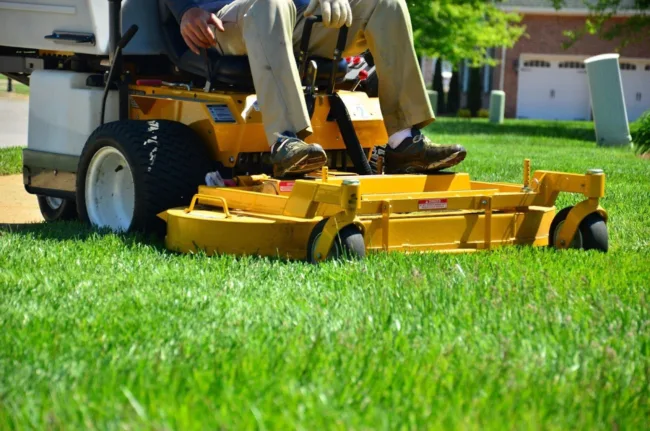
A neatly trimmed lawn isn’t just about aesthetics, it’s a powerful investment in your property’s value, your neighborhood appeal, and your household’s outdoor experience. From national lawn care trends to insider mowing tips, this article dives into the numbers behind America’s yard obsession, and how homeowners can get the most out of their green spaces.
Lawn Mowing by the Numbers
Lawn care is more than just a weekend chore, it’s a multi-billion dollar industry in the United States. According to the National Association of Landscape Professionals, over 81% of Americans have a lawn, and the average homeowner spends around 70 hours a year on lawn care tasks.
Yard Sizes and Regional Differences
Yard sizes vary dramatically by region. In the Midwest and South, the average residential yard is around 0.3 acres, while urban homes in the Northeast and West tend to have significantly smaller plots, often less than 0.1 acres.
In suburban areas, larger lawns remain a priority for homeowners looking for recreational space, privacy, and curb appeal. Yet, even small lawns demand attention and consistency. This is why on-demand mowing apps are increasingly popular among busy families and aging homeowners.
Why Mowing Frequency Matters
One of the most common mistakes homeowners make is mowing too infrequently or cutting the grass too short. This can stress the turf and leave it vulnerable to pests, weeds, and drought.
The One-Third Rule
A helpful rule of thumb is the one-third rule: never cut more than one-third of the grass blade height at a time. This keeps your lawn healthy and encourages deeper root growth.
For example, if you’re maintaining a lawn at 3 inches high, don’t let it grow taller than 4.5 inches before mowing. During peak growing seasons, typically late spring and early summer, you may need to mow every 5 to 7 days.
Seasonal Mowing Patterns
Understanding seasonal patterns can help you create a smarter mowing schedule:
- Spring: Lawns grow rapidly due to increased rainfall and moderate temperatures. Mowing weekly is often necessary.
- Summer: Depending on rainfall and heat, growth may slow. Consider raising your mower height to protect roots from sun stress.
- Fall: Grass growth picks up again. Regular mowing continues until the first frost.
- Winter: In most climates, growth halts. This is a good time to service your mower or explore switching to a robotic or electric model.
Mowing Techniques That Protect Your Lawn
Here are some household mowing habits that make a measurable difference:
Change Directions
Mowing in the same direction every time compacts the soil and causes ruts. Switch up your mowing direction regularly to help the blades stand upright and improve grass health.
Keep Your Mower Blades Sharp
Dull blades tear the grass instead of cutting it, leading to jagged edges that brown quickly. Sharpen your blades at least once every season, or more if you’re mowing weekly.
Don’t Mow When It’s Wet
Wet grass clumps, blocks airflow, and clogs your mower. Waiting for the yard to dry prevents uneven cuts and soil damage.
The Lawn-Guru Effect: Modernizing Yard Care
Technology is changing how we care for our yards. Platforms like https://lawnguru.co/ are reshaping the landscape, literally and figuratively, by giving homeowners instant access to professional mowing services with just a few clicks.
These apps allow users to:
- Schedule same-day mowing
- Skip or reschedule without penalties
- Receive photo updates when jobs are complete
- Compare provider ratings and pricing upfront
This flexibility has made on-demand mowing a go-to solution in cities with dense populations or rapidly changing weather.
The Impact of Lawns on Home Value
A healthy lawn can increase your home’s perceived value by up to 15%. In real estate surveys, buyers consistently rank curb appeal as one of the most influential factors when making purchasing decisions.
Return on Investment
Basic lawn care like mowing, fertilization, and weed control can offer a ROI of 267%, one of the highest among home improvement projects. It’s low-cost, high-impact, and easily scalable whether you’re prepping for a sale or just want to improve your outdoor space.
Eco-Friendly Lawn Tips for the Modern Home
Mowing smarter isn’t just about looks, it’s also a chance to reduce your environmental footprint.
Leave Grass Clippings Behind
Mulching instead of bagging returns nutrients to the soil and helps retain moisture. It also reduces the amount of green waste sent to landfills.
Go Electric
Electric mowers and trimmers are quieter, cleaner, and increasingly affordable. Many states now offer rebates for switching to electric lawn equipment.
Consider Native Grasses
Choosing grass varieties that are naturally adapted to your region cuts down on the need for water, fertilizer, and frequent mowing.
Final Thoughts
Mowing may seem like a mundane chore, but it’s a powerful tool in your home maintenance routine. Whether you have a sprawling yard in the suburbs or a small city plot, how you mow, and how often, makes a difference in your home’s value, appearance, and ecosystem.
With innovative services like https://lawnguru.co/, lawn care no longer has to compete with your busy schedule. Whether you mow it yourself or tap into modern solutions, staying consistent is the key to a yard that’s not just flashy, but functional, too.
